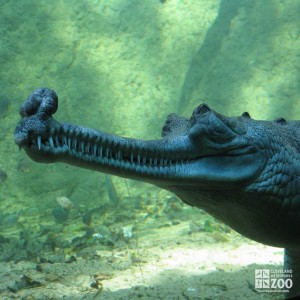Gharial
[Gavialis gangeticus]

The gharial is one of the longest crocodilians. Adult males can reach 16 to 20 feet. Females are smaller, reaching 13 feet. Weight averages 200 to 500 pounds but can be up to 1,000 pounds. Gharials have slender, elongated snouts. In mature males the snout is tipped with a large bulbous mass known as the ghara, after the Indian word for “pot," which it resembles. The ghara’s function is not known, but it is thought to produce a loud buzzing noise when vocalizing to attract females. The jaws are equipped with sharp pointed teeth. The hide is tough and is sought after by hunters.
Location: The Lower RainForest
Share:
Range
The gharial's range is India, Nepal, and Pakistan.
Habitat
Gharials inhabit freshwater rivers with deep pools and sandy or muddy banks.
Conservation Status
Critically EndangeredPrimary Threats
Human Wildlife CoexistenceGestation
Incubation: 60-90 days
Litter
Clutch: 35-60 eggs
Behavior
Gharials are clumsy on land, as their leg musculature does not allow them to raise their body or tail off the ground. They can, however, belly-slide quickly if need be. They are the most aquatic member of the order, and leave the water only to bask or nest, usually on a sandy river bank. They spend much of the time lying just under the surface of the water, with only the eyes and nostrils exposed. Despite their enormous size, they tend to avoid rather than attack people. The long and narrow jaws are not strong enough to grasp and tear apart large prey as other crocodiles do for food.
Reproduction
Female gharials reach sexual maturity at about 9 feet in length and usually over 10 years of age. Males guard a harem of several females. Mating period occurs for 2 months during November, December and January. Nesting is in March, April and May (the dry season), when hole nests are dug into sand banks. The eggs are deposited into the hole before it is covered carefully. Gharial eggs are the largest of any crocodilian species, weighing on average 5.6 ounces. After the incubation period of 60 to 90 days, juveniles emerge. The female has not been observed assisting the hatchlings to the water as in other crocodilian species; however, the young are protected around the nesting area after hatching.
Wild Diet
Invertebrates, frogs, fish
Zoo Diet
Fish

